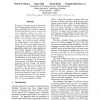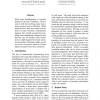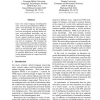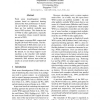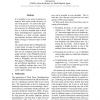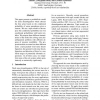EMNLP
2009
13 years 9 months ago
2009
In this paper, we address the issue of automatic extending lexical resources by exploiting existing knowledge repositories. In particular, we deal with the new task of linking Fra...
EMNLP
2009
13 years 9 months ago
2009
We report in this paper a way of doing Word Sense Disambiguation (WSD) that has its origin in multilingual MT and that is cognizant of the fact that parallel corpora, wordnets and...
EMNLP
2009
13 years 9 months ago
2009
Word sense disambiguation is typically phrased as the task of labeling a word in context with the best-fitting sense from a sense inventory such as WordNet. While questions have o...
CLEF
2009
Springer
13 years 9 months ago
2009
Springer
In this paper, we describe the TNO approach to the Finding Related Resources or linking task of VideoCLEF09. Our system consists of a weighted combination of off-theshelf and prop...
NLDB
2010
Springer
13 years 9 months ago
2010
Springer
This paper tackles the problem of term ambiguity, especially for biomedical literature. We propose and evaluate two methods of Word Sense Disambiguation (WSD) for biomedical terms ...
NAACL
2010
13 years 9 months ago
2010
Like most natural language disambiguation tasks, word sense disambiguation (WSD) requires world knowledge for accurate predictions. Several proxies for this knowledge have been in...
EMNLP
2010
13 years 9 months ago
2010
Graph-based methods have gained attention in many areas of Natural Language Processing (NLP) including Word Sense Disambiguation (WSD), text summarization, keyword extraction and ...
ACL
2010
13 years 9 months ago
2010
Word sense disambiguation (WSD) systems based on supervised learning achieved the best performance in SensEval and SemEval workshops. However, there are few publicly available ope...
ACL
2010
13 years 9 months ago
2010
Is it possible to use sense inventories to improve Web search results diversity for one word queries? To answer this question, we focus on two broad-coverage lexical resources of ...
ACL
2010
13 years 9 months ago
2010
This paper presents a probabilistic model for sense disambiguation which chooses the best sense based on the conditional probability of sense paraphrases given a context. We use a...

